Contents
 |
This is a timeline of the history of Quebec City .
 |
This is a timeline of the history of Quebec City .
| Wikimedia Commons has media related to Ville de Québec . |

Quebec City, officially Québec, is the capital city of the Canadian province of Quebec. As of July 2016, the city had a population of 531,902, and the metropolitan area had a population of 800,296. It is the eleventh-largest city and the seventh-largest metropolitan area in Canada. It is also the second-largest city in the province after Montreal. It has a humid continental climate with warm summers coupled with cold and snowy winters.

This section of the Timeline of Quebec history concerns the events between the foundation of Quebec and establishment of the Sovereign Council.
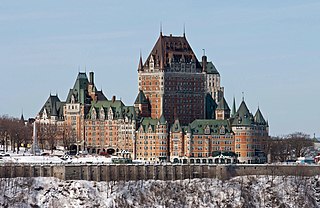
The Fairmont Le Château Frontenac, commonly referred to as the Château Frontenac, is a historic hotel in Quebec City, Quebec, Canada. The hotel is situated in Old Quebec, within the historic district's Upper Town, on the southern side of Place d'Armes. The Château Frontenac was designed by Bruce Price, and was built by the Canadian Pacific Railway company. The hotel is managed by Fairmont Hotels and Resorts.

The Legislative Council of Quebec was the unelected upper house of the bicameral legislature in the Canadian province of Quebec from 1867 to 1968. The Legislative Assembly was the elected lower house.
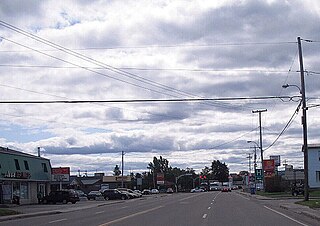
Roberval is a city on the south-western shore of Lac Saint-Jean in the Le Domaine-du-Roy Regional County Municipality of Quebec, Canada. With a population of 9,840 in the Canada 2021 Census, it is the fourth largest city on this lake after Alma, Dolbeau-Mistassini and Saint-Félicien. It is the seat of the Domaine-du-Roy RCM and the main service centre for the region with a hospital and some government services. It is also the seat of the judicial district of Roberval.
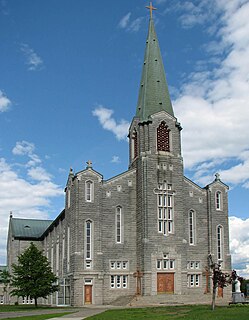
Montmagny is a city in the Montmagny Regional County Municipality within the Chaudière-Appalaches region of Quebec. It is the county seat and had a population, as of the Canada 2011 Census, of 11,491.
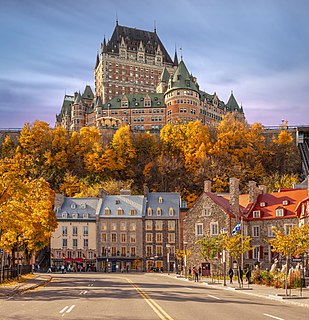
Old Quebec is a historic neighbourhood of Quebec City, Quebec, Canada. Comprising the Upper Town and Lower Town, the area is a UNESCO World Heritage Site. Administratively, Old Quebec is part of the Vieux-Québec–Cap-Blanc–colline Parlementaire district in the borough of La Cité-Limoilou.

The Édifice Marie-Guyart, previously and still commonly known as Complexe G, is a 31-storey, 132 m (433 ft) office skyscraper completed in 1972 in Quebec City, Quebec, Canada. The brutalist style tower is the tallest building in the city, as well as the tallest building in Canada east of Montreal. Situated in the Parliament Hill borough, the building houses most notably the Ministry of Education, Recreation and Sports, the Ministry of Sustainable Development, Environment and Parks, as well the Observatoire de la Capitale observation deck.
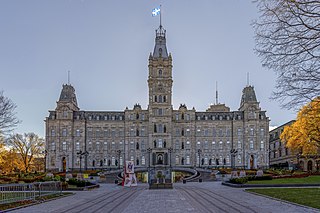
The Parliament Building of Quebec is an eight-floor structure and is home to the National Assembly of Quebec, located in Quebec City, Quebec, Canada. The Parliament Building was designed by architect Eugène-Étienne Taché in a Second Empire style and built between 1877 and 1886, in the heart of Quebec's Parliament Hill. The National Assembly first met there on March 27, 1884, even as the building was fully completed only two years later, on April 8, 1886. In 1910s-1930s, the government has built several adjacent buildings to expand its office spaces, creating a parliamentary complex, of which the Parliament Building is the main edifice. The government office, is a successor of several earlier buildings, the earliest of which was built in 1620 and among which there were two other parliament houses that served as legislatures from 1791.
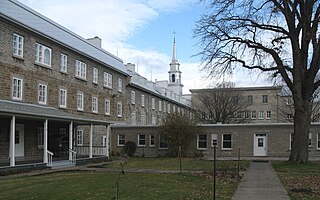
Notre-Dame-des-Anges is a parish municipality in Quebec, Canada, home of the General Hospital of Quebec.

The history of Quebec City extends back thousands of years, with its first inhabitants being the First Nations peoples of the region. The arrival of French explorers in the 16th century eventually led to the establishment of Quebec City, in present-day Quebec, Canada. The city is one of the oldest European settlements in North America, with the establishment of a permanent trading post in 1608.

The Congrégation de Notre Dame (CND) is a religious community for women founded in 1658 in Ville Marie (Montreal), in the colony of New France, now part of Canada. It was established by Marguerite Bourgeoys, who created a religious community for women that was not cloistered; the sisters were allowed to live and work outside the convent. The Congregation held an important role in the development of New France, as it supported women and girls in the colony and offered roles for them outside the home. It also founded a boarding school for girls' education, watched over the filles du roi, women immigrants whose passage to the colony was paid by the Crown, which wished to encourage marriages and the development of families in the colony. Some filles de roi and sisters served as missionaries to the First Nations peoples. The community's motherhouse has been based in Montreal for more than 350 years. Marguerite Bourgeoys was canonized in 1982 by the Roman Catholic Church and is Canada's first woman saint.
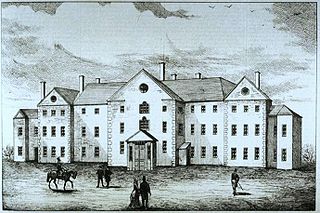
The Chateau St. Louis in Quebec City was the official residence of the French Governor of New France and later the British Governor of Quebec, the Governor-General of British North America, and the Lieutenant-Governor of Lower Canada.
The timeline of the history of Montreal is a chronology of significant events in the history of Montreal, Canada's second-most populated city, with about 3.5 million residents in 2018, and the fourth-largest French-speaking city in the world.

The Hôpital-Général de Québec is a Canadian medical facility located in the tiny municipality of Notre-Dame-des-Anges, Quebec, surrounded by the La Cité-Limoilou borough of Quebec City. It was classified as an historic site in 1977 by the Quebec government. Additionally, an archeological site listed on the Inventaire des sites archéologiques du Québec is located there.

Duke of Kent House or Kent House is situated on the corner of Rue Saint-Louis and Haldimand, behind the Château Frontenac in Quebec City, named after its most famous resident Prince Edward, Duke of Kent and Strathearn. Though altered and transformed since its original construction, the most part of its foundations and of the first floor walls date back to the vicinity of 1650, making it one of the oldest houses, if not the oldest house in Quebec City. In 1759, the Articles of Capitulation of Quebec were signed within the house. The present edifice has remained largely unchanged since 1819. It served as the French Consulate from 1980 to 2015.

Vieux-Québec–Cap-Blanc–Colline Parlementaire is one of the 35 districts of the City of Quebec, and one of six that are located in the borough of La Cité-Limoilou. The district is the most visited and toured location in the city. It is in this partly fortified area where the Château Frontenac is found, with its large terrace overlooking the city of Lévis, across the Saint Lawrence River. A large concentration of cafes, tourist shops, restaurants, hotels and inns are situated in the district. In its most recent census count in 2016, Statistics Canada reported that the district had a population of 5,770 residents, whom comprise 1.1% of the city's total population.

Captain François-Marie Renaud d'Avène des Méloizes was a French Cavalry officer who came to New France in 1685 in command of the Troupes de Marine and led the successful expedition against the Senecas. The Comte de Frontenac considered him "one of the best and wisest officers" in Canada. He is buried in the vaults of Notre-Dame Basilica-Cathedral, Quebec City.